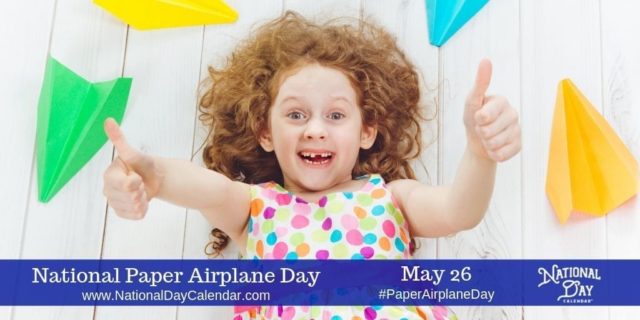
National Paper Airplane Day is celebrated every year on May 26 in the United States. It commemorates the simple aeronautical toy that’s been around for thousands of years.
- Flying paper planes is an inexpensive, healthy, and stimulating form of entertainment.
- The use of paper airplanes is believed to have originated 2,000 years ago in China. The earliest known date of the creation of modern paper planes was said to have been in 1909.
- The invention of the paper airplane is mystery, but Leonardo Di Vinci is often given credit for the feat.
- Scientists, engineers and students use paper airplanes to study aerodynamics. The National Aeronautics and Space Administration (NASA) sent a paper airplane to space on a space shuttle.
- The humidity outside can affect the performance of a paper airplane thrown inside.
- The longest time flying a paper aircraft is currently 29.2 sec and was achieved by Takuo Toda (Japan), in Fukuyama City, Hiroshima, Japan, on 19 December 2010.
- The record distance for a paper plane to be thrown is currently held by Joe Ayoob using a plane designed by John Collins. The throw was made on 26 February 2012 at the McClellan Air Force Base near Sacramento in the United States and the distance – 226 feet and 10 inches (69.14 meters).
- On 24 June 2015 David Green achieved the highest altitude paper plane launch recording an altitude of 35,043 metres (114,970.5 feet). The plane was launched as part of a high school science club activity.
- The largest paper aircraft was made on 28 September 2013 by students and employees at the Braunschweig Institute of Technology in Braunschweig, Germany. It was launched in an aircraft hangar from a platform 8.10 feet (2.47 m) high and flew just over 59 feet (18 meters). The plane was made from paper and took 14 people 1,200 hours to build it. The plane had a span width of 59.7 feet (18.21 meters).
- Ever wondered how a paper airplane thrown in space would fly? Here’s a video of Japanese Astronaut Takuya Onishi throwing a paper plane on board a space shuttle. Takuya Onishi is a Japanese astronaut who was selected for the Japan Aerospace Exploration Agency (JAXA) and spent four months onboard the International Space Station in 2016.
Sources:












